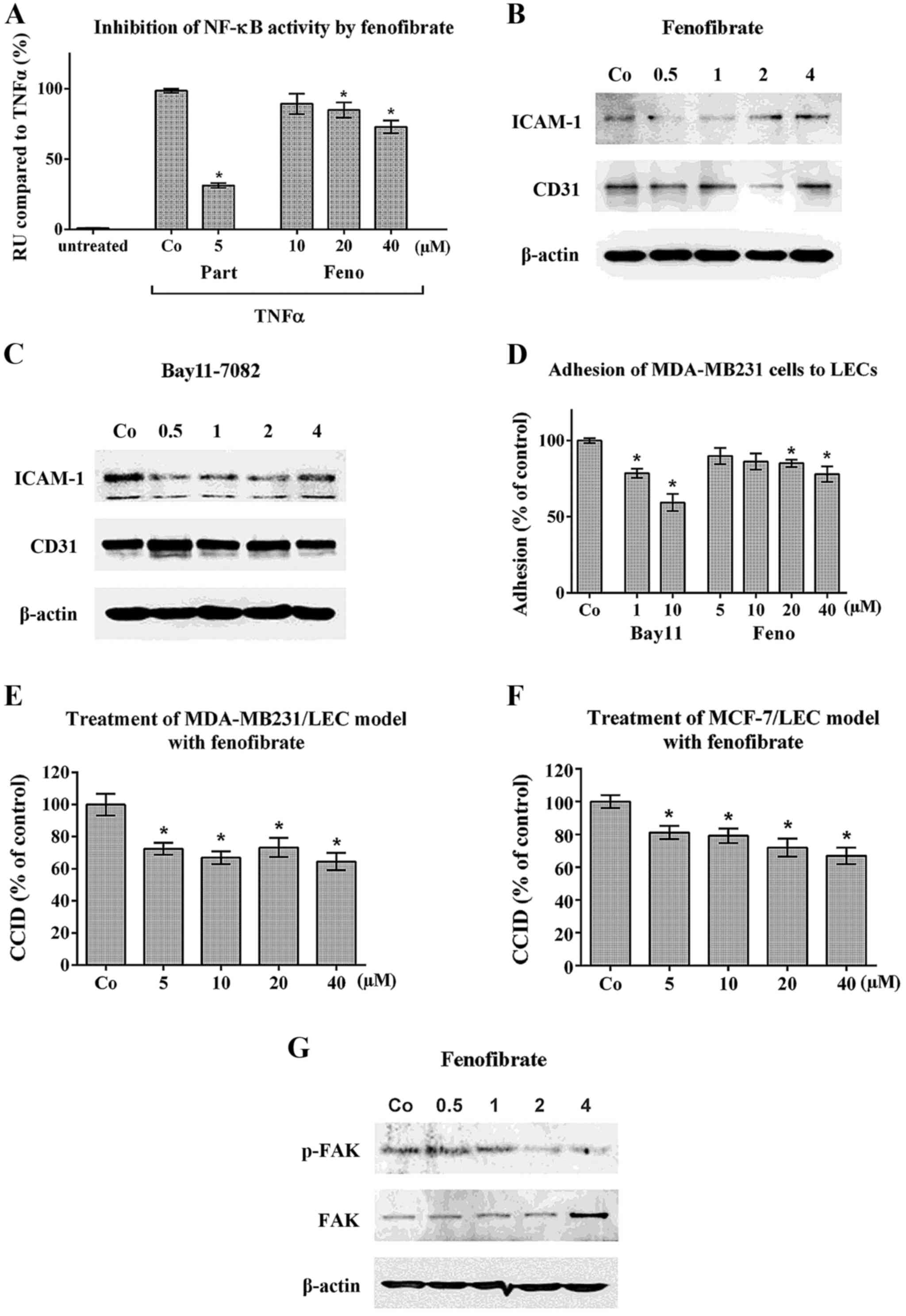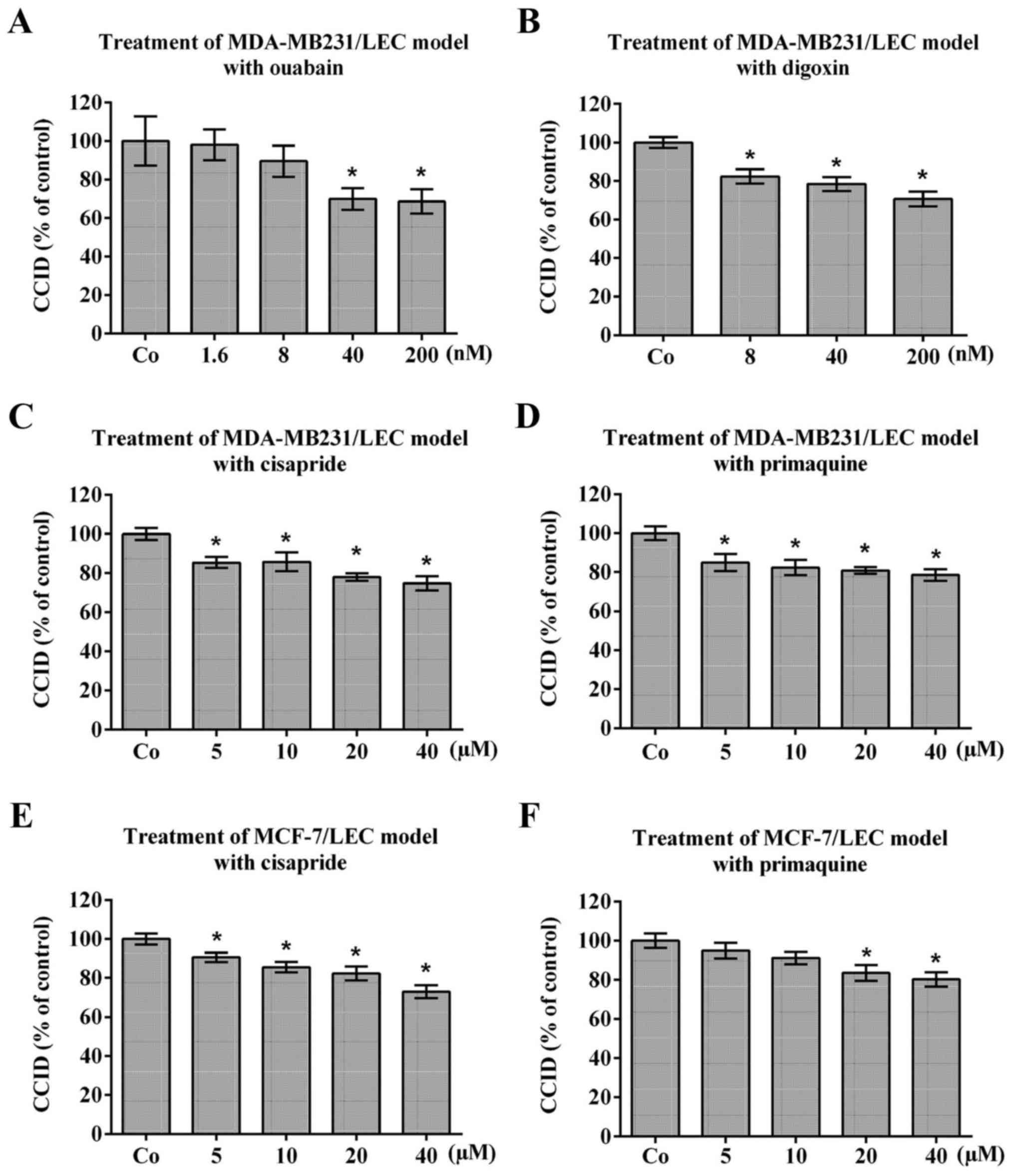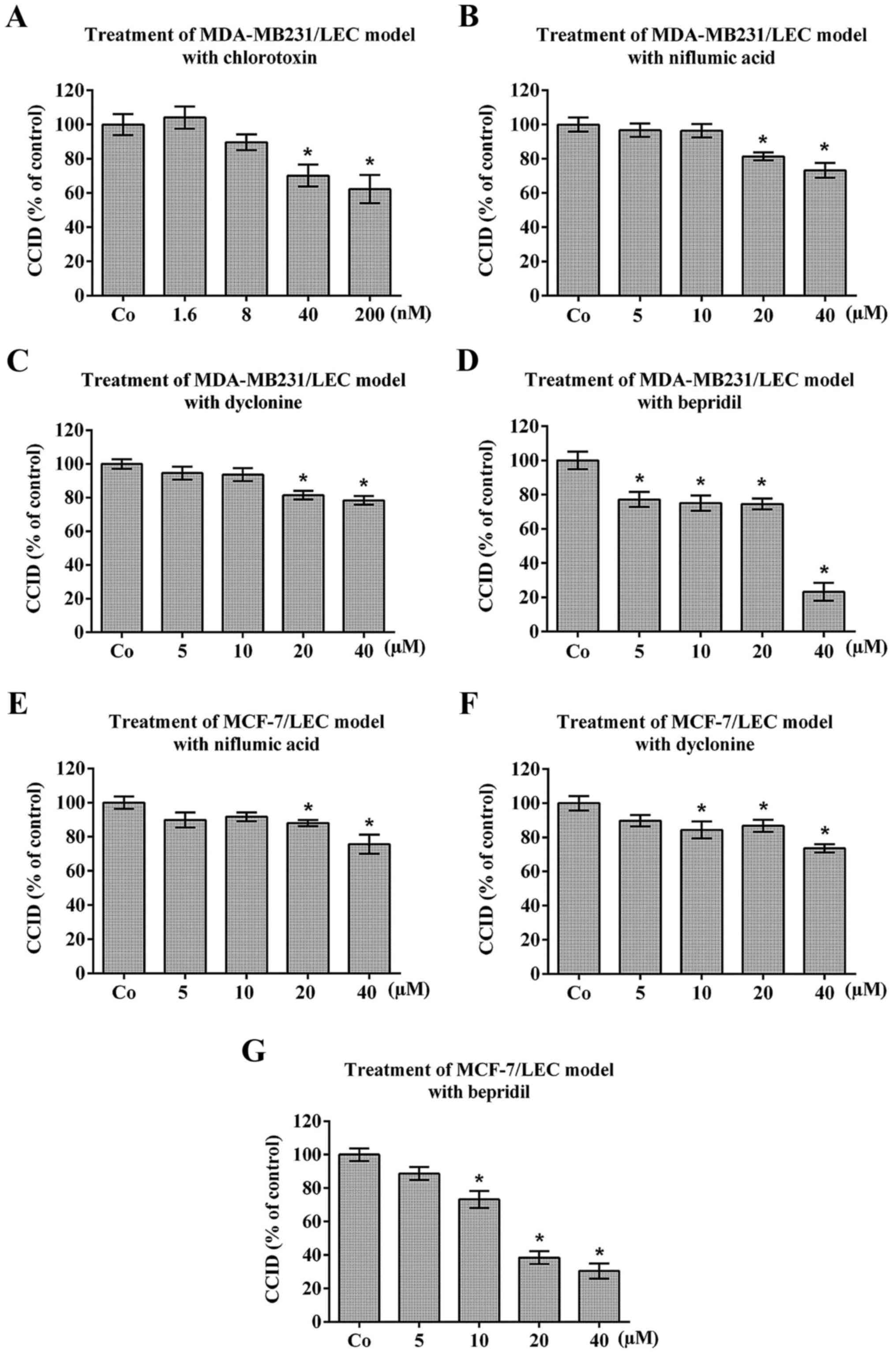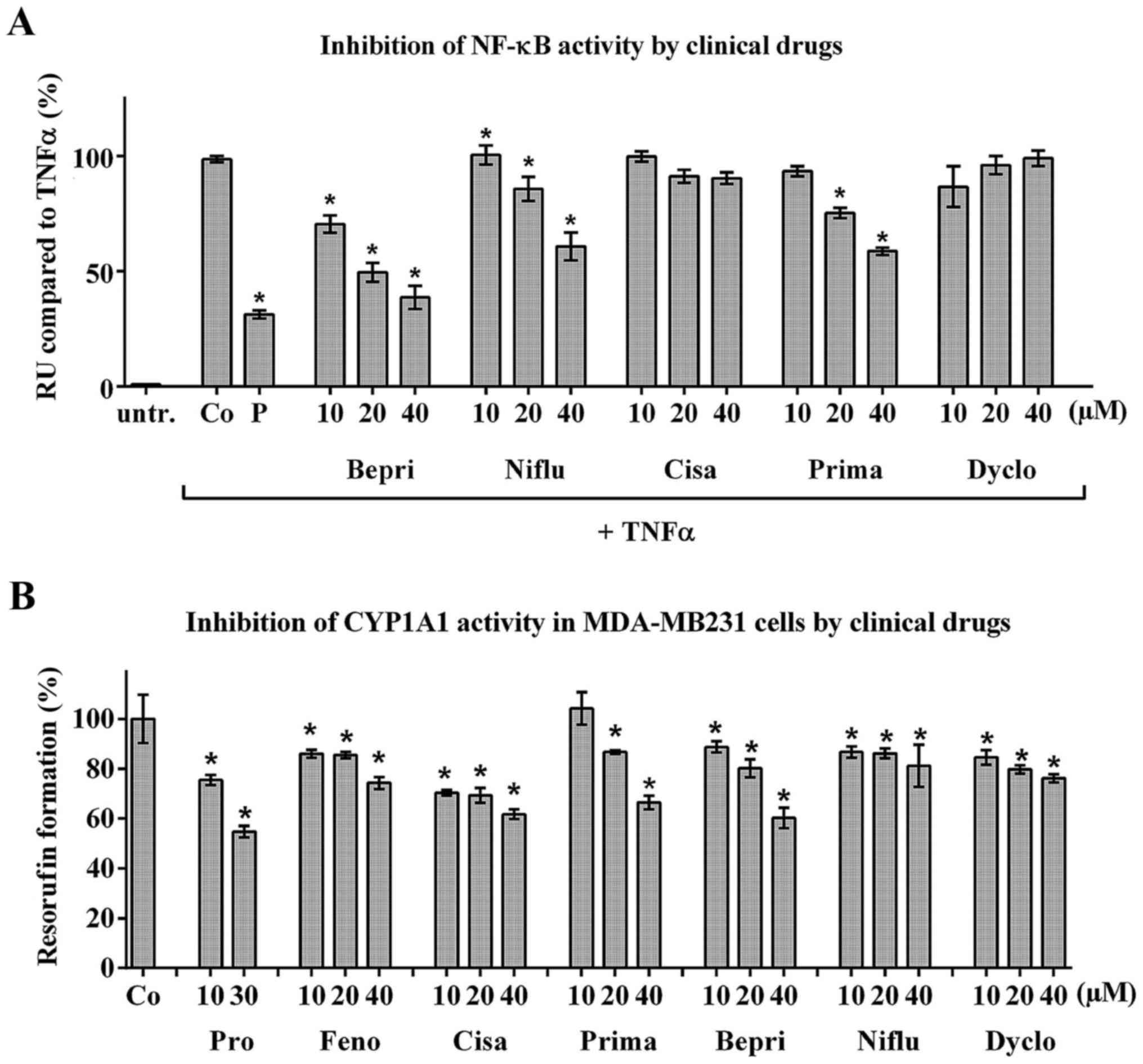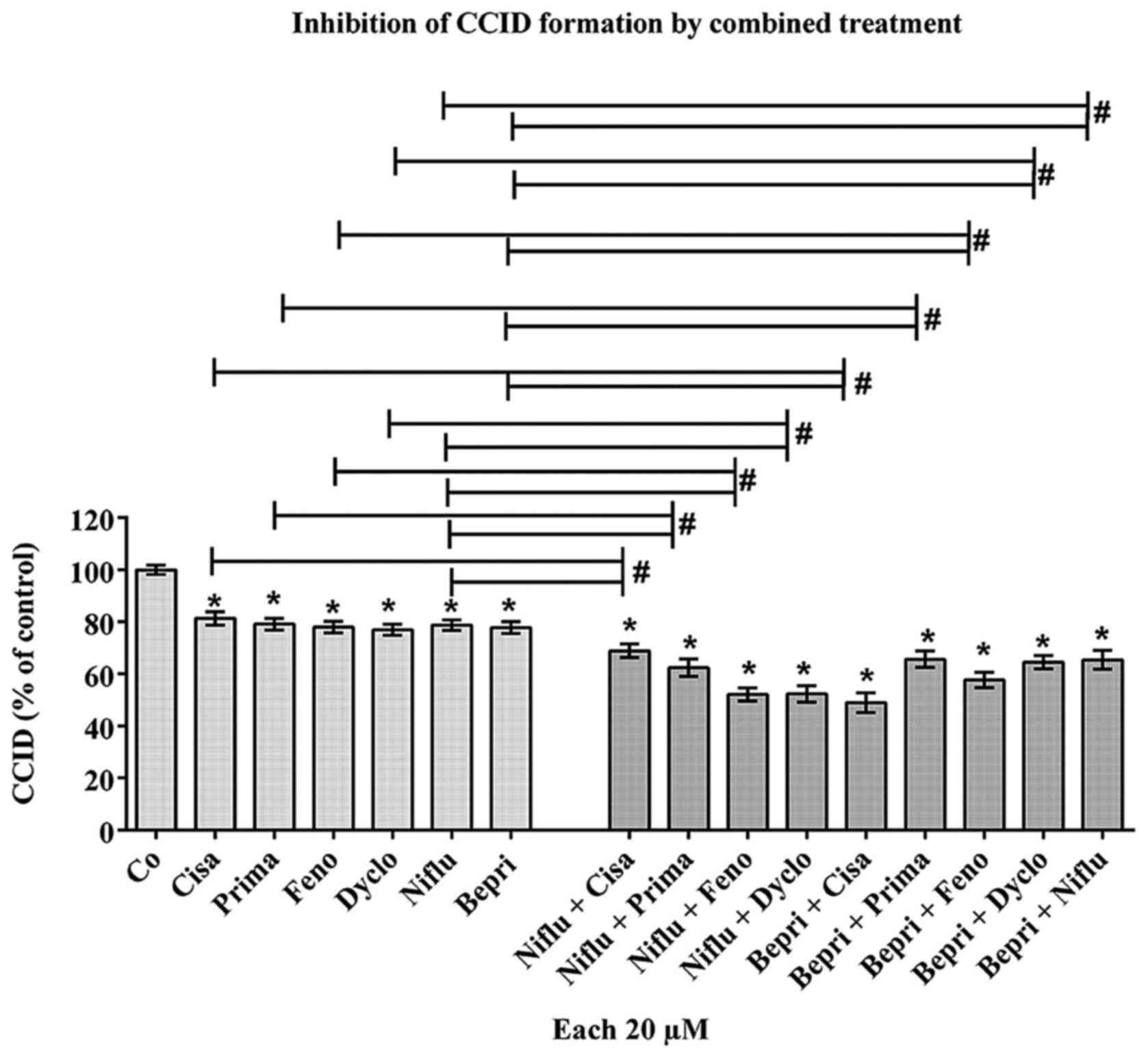|
1
|
Sobin LH, Gospodarowicz MK and Wittekind
C: TNM Classification of Malignant Tumours (UICC International
Union Against Cancer). 7th edition. Wiley-Blackwell; New York:
2009
|
|
2
|
Vonach C, Viola K, Giessrigl B, Huttary N,
Raab I, Kalt R, Krieger S, Vo TP, Madlener S, Bauer S, et al: NF-κB
mediates the 12(S)-HETE-induced endothelial to mesenchymal
transition of lymphendothelial cells during the intravasation of
breast carcinoma cells. Br J Cancer. 105:263–271. 2011. View Article : Google Scholar : PubMed/NCBI
|
|
3
|
Viola K, Kopf S, Huttary N, Vonach C,
Kretschy N, Teichmann M, Giessrigl B, Raab I, Stary S, Krieger S,
et al: Bay11-7082 inhibits the disintegration of the
lymphendothelial barrier triggered by MCF-7 breast cancer
spheroids; the role of ICAM-1 and adhesion. Br J Cancer.
108:564–569. 2013. View Article : Google Scholar :
|
|
4
|
Nguyen CH, Senfter D, Basilio J, Holzner
S, Stadler S, Krieger S, Huttary N, Milovanovic D, Viola K,
Simonitsch-Klupp I, et al: NF-κB contributes to MMP1 expression in
breast cancer spheroids causing paracrine PAR1 activation and
disintegrations in the lymph endothelial barrier in vitro.
Oncotarget. 6:39262–39275. 2015.PubMed/NCBI
|
|
5
|
Piwowarczyk K, Wybieralska E, Baran J,
Borowczyk J, Rybak P, Kosińska M, Włodarczyk AJ, Michalik M,
Siedlar M, Madeja Z, et al: Fenofibrate enhances barrier function
of endothelial continuum within the metastatic niche of prostate
cancer cells. Expert Opin Ther Targets. 19:163–176. 2015.
View Article : Google Scholar
|
|
6
|
Madlener S, Saiko P, Vonach C, Viola K,
Huttary N, Stark N, Popescu R, Gridling M, Vo NT, Herbacek I, et
al: Multifactorial anticancer effects of digalloyl-resveratrol
encompass apoptosis, cell-cycle arrest, and inhibition of
lymphendothelial gap formation in vitro. Br J Cancer.
102:1361–1370. 2010. View Article : Google Scholar : PubMed/NCBI
|
|
7
|
Kerjaschki D, Bago-Horvath Z, Rudas M,
Sexl V, Schneckenleithner C, Wolbank S, Bartel G, Krieger S, Kalt
R, Hantusch B, et al: Lipoxygenase mediates invasion of
intrametastatic lymphatic vessels and propagates lymph node
metastasis of human mammary carcinoma xenografts in mouse. J Clin
Invest. 121:2000–2012. 2011. View Article : Google Scholar : PubMed/NCBI
|
|
8
|
Nguyen CH, Brenner S, Huttary N, Li Y,
Atanasov AG, Dirsch VM, Holzner S, Stadler S, Riha J, Krieger S, et
al: 12(S)-HETE increases intracellular Ca(2+) in lymph-endothelial
cells disrupting their barrier function in vitro; stabilization by
clinical drugs impairing calcium supply. Cancer Lett. 380:174–183.
2016. View Article : Google Scholar : PubMed/NCBI
|
|
9
|
Nguyen CH, Stadler S, Brenner S, Huttary
N, Krieger S, Jäger W, Dolznig H and Krupitza G: Cancer
cell-derived 12(S)-HETE signals via 12-HETE receptor, RHO, ROCK and
MLC2 to induce lymph endothelial barrier breaching. Br J Cancer.
115:364–370. 2016. View Article : Google Scholar : PubMed/NCBI
|
|
10
|
Litan A and Langhans SA: Cancer as a
channelopathy: Ion channels and pumps in tumor development and
progression. Front Cell Neurosci. 9:862015. View Article : Google Scholar : PubMed/NCBI
|
|
11
|
Comes N, Serrano-Albarrás A, Capera J,
Serrano-Novillo C, Condom E, Ramón Y, Cajal S, Ferreres JC and
Felipe A: Involvement of potassium channels in the progression of
cancer to a more malignant phenotype. Biochim Biophys Acta.
1848.2477–2492. 2015.
|
|
12
|
Northcott PA, Dubuc AM, Pfister S and
Taylor MD: Molecular subgroups of medulloblastoma. Expert Rev
Neurother. 12:871–884. 2012. View Article : Google Scholar : PubMed/NCBI
|
|
13
|
Su C, Shi A, Cao G, Tao T, Chen R, Hu Z,
Shen Z, Tao H, Cao B, Hu D, et al: Fenofibrate suppressed
proliferation and migration of human neuroblastoma cells via
oxidative stress dependent of TXNIP upregulation. Biochem Biophys
Res Commun. 460:983–988. 2015. View Article : Google Scholar : PubMed/NCBI
|
|
14
|
Goetze S, Eilers F, Bungenstock A,
Kintscher U, Stawowy P, Blaschke F, Graf K, Law RE, Fleck E and
Gräfe M: PPAR activators inhibit endothelial cell migration by
targeting Akt. Biochem Biophys Res Commun. 293:1431–1437. 2002.
View Article : Google Scholar : PubMed/NCBI
|
|
15
|
Wolle D, Lee SJ, Li Z, Litan A, Barwe SP
and Langhans SA: Inhibition of epidermal growth factor signaling by
the cardiac glycoside ouabain in medulloblastoma. Cancer Med.
3:1146–1158. 2014. View Article : Google Scholar : PubMed/NCBI
|
|
16
|
Hu X, Wei L, Taylor TM, Wei J, Zhou X,
Wang JA and Yu SP: Hypoxic preconditioning enhances bone marrow
mesenchymal stem cell migration via Kv2.1 channel and FAK
activation. Am J Physiol Cell Physiol. 301:C362–C372. 2011.
View Article : Google Scholar : PubMed/NCBI
|
|
17
|
Wei JF, Wei L, Zhou X, Lu ZY, Francis K,
Hu XY, Liu Y, Xiong WC, Zhang X, Banik NL, et al: Formation of
Kv2.1-FAK complex as a mechanism of FAK activation, cell
polarization and enhanced motility. J Cell Physiol. 217:544–557.
2008. View Article : Google Scholar : PubMed/NCBI
|
|
18
|
Bajwa PJ, Alioua A, Lee JW, Straus DS,
Toro L and Lytle C: Fenofibrate inhibits intestinal Cl- secretion
by blocking baso-lateral KCNQ1 K+ channels. Am J Physiol
Gastrointest Liver Physiol. 293:G1288–G1299. 2007. View Article : Google Scholar : PubMed/NCBI
|
|
19
|
Shimomura K, Shimizu H, Ikeda M, Okada S,
Kakei M, Matsumoto S and Mori M: Fenofibrate, troglitazone, and
15-deoxy-Delta12,14-prostaglandin J2 close KATP channels and induce
insulin secretion. J Pharmacol Exp Ther. 310:1273–1280. 2004.
View Article : Google Scholar : PubMed/NCBI
|
|
20
|
Shimomura K, Ikeda M, Ariyama Y, Proks P,
Shimomura Y, Mori M and Matsumoto S: Effect of peroxisome
proliferator-activated receptor alpha ligand fenofibrate on K(v)
channels in the insulin-secreting cell line HIT-T15. Gen Physiol
Biophys. 25:455–460. 2006.
|
|
21
|
De Ciuceis C, Amiri F, Iglarz M, Cohn JS,
Touyz RM and Schiffrin EL: Synergistic vascular protective effects
of combined low doses of PPARalpha and PPARgamma activators in
angiotensin II-induced hypertension in rats. Br J Pharmacol.
151:45–53. 2007. View Article : Google Scholar : PubMed/NCBI
|
|
22
|
Grabacka M, Plonka PM, Urbanska K and
Reiss K: Peroxisome proliferator-activated receptor alpha
activation decreases metastatic potential of melanoma cells in
vitro via down-regulation of Akt. Clin Cancer Res. 12:3028–3036.
2006. View Article : Google Scholar : PubMed/NCBI
|
|
23
|
Zhang N, Chu ES, Zhang J, Li X, Liang Q,
Chen J, Chen M, Teoh N, Farrell G, Sung JJ, et al: Peroxisome
proliferator activated receptor alpha inhibits hepatocarcinogenesis
through mediating NF-κB signaling pathway. Oncotarget. 5:8330–8340.
2014. View Article : Google Scholar : PubMed/NCBI
|
|
24
|
Rival Y, Benéteau N, Taillandier T, Pezet
M, Dupont-Passelaigue E, Patoiseau JF, Junquéro D, Colpaert FC and
Delhon A: PPARalpha and PPARdelta activators inhibit
cytokine-induced nuclear translocation of NF-kappaB and expression
of VCAM-1 in EAhy926 endothelial cells. Eur J Pharmacol.
435:143–151. 2002. View Article : Google Scholar : PubMed/NCBI
|
|
25
|
Han D, Wei W, Chen X, Zhang Y, Wang Y,
Zhang J, Wang X, Yu T, Hu Q, Liu N, et al: NF-κB/RelA-PKM2 mediates
inhibition of glycolysis by fenofibrate in glioblastoma cells.
Oncotarget. 6:26119–26128. 2015. View Article : Google Scholar : PubMed/NCBI
|
|
26
|
Chandran K, Goswami S and Sharma-Walia N:
Implications of a peroxisome proliferator-activated receptor alpha
(PPARα) ligand clofibrate in breast cancer. Oncotarget.
7:15577–15599. 2016.
|
|
27
|
Abu Aboud O, Wettersten HI and Weiss RH:
Inhibition of PPARα induces cell cycle arrest and apoptosis, and
synergizes with glycolysis inhibition in kidney cancer cells. PLoS
One. 8:e711152013. View Article : Google Scholar
|
|
28
|
Huang WP, Yin WH, Chen JW, Jen HL, Young
MS and Lin SJ: Fenofibrate attenuates endothelial monocyte adhesion
in chronic heart failure: An in vitro study. Eur J Clin Invest.
39:775–783. 2009. View Article : Google Scholar : PubMed/NCBI
|
|
29
|
Tsai SC, Tsai MH, Chiu CF, Lu CC, Kuo SC,
Chang NW and Yang JS: AMPK-dependent signaling modulates the
suppression of invasion and migration by fenofibrate in CAL 27 oral
cancer cells through NF-κB pathway. Environ Toxicol. 31:866–876.
2016. View Article : Google Scholar
|
|
30
|
Koh KK, Oh PC, Sakuma I, Lee Y, Han SH and
Shin EK: Vascular and metabolic effects of omega-3 fatty acids
combined with fenofibrate in patients with hypertriglyceridemia.
Int J Cardiol. 221:342–346. 2016. View Article : Google Scholar : PubMed/NCBI
|
|
31
|
Teichmann M, Kretschy N, Kopf S,
Jarukamjorn K, Atanasov AG, Viola K, Giessrigl B, Saiko P, Szekeres
T, Mikulits W, et al: Inhibition of tumour spheroid-induced
prometastatic intravasation gates in the lymph endothelial cell
barrier by carbamazepine: Drug testing in a 3D model. Arch Toxicol.
88:691–699. 2014.
|
|
32
|
Rozema E, Atanasov AG, Fakhrudin N,
Singhuber J, Namduang U, Heiss EH, Reznicek G, Huck CW, Bonn GK,
Dirsch VM, et al: Selected extracts of Chinese herbal medicines:
Their effect on NF-κB, PPARα and PPARγ and the respective bioactive
compounds. Evid Based Complement Alternat Med. 2012:9830232012.
View Article : Google Scholar
|
|
33
|
Gu J, Tamura M, Pankov R, Danen EH, Takino
T, Matsumoto K and Yamada KM: Shc and FAK differentially regulate
cell motility and directionality modulated by PTEN. J Cell Biol.
146:389–403. 1999. View Article : Google Scholar : PubMed/NCBI
|
|
34
|
Wang HB, Dembo M, Hanks SK and Wang Y:
Focal adhesion kinase is involved in mechanosensing during
fibroblast migration. Proc Natl Acad Sci USA. 98:11295–11300. 2001.
View Article : Google Scholar : PubMed/NCBI
|
|
35
|
Cherniavsky Lev M, Karlish SJ and Garty H:
Cardiac glycosides induced toxicity in human cells expressing α1-,
α2-, or α3-isoforms of Na-K-ATPase. Am J Physiol Cell Physiol.
309:C126–C135. 2015. View Article : Google Scholar : PubMed/NCBI
|
|
36
|
Rodrigues-Mascarenhas S, Da Silva de
Oliveira A, Amoedo ND, Affonso-Mitidieri OR, Rumjanek FD and
Rumjanek VM: Modulation of the immune system by ouabain. Ann NY
Acad Sci. 1153:153–163. 2009. View Article : Google Scholar : PubMed/NCBI
|
|
37
|
Pongrakhananon V, Chunhacha P and
Chanvorachote P: Ouabain suppresses the migratory behavior of lung
cancer cells. PLoS One. 8:e686232013. View Article : Google Scholar : PubMed/NCBI
|
|
38
|
Lin SY, Chang HH, Lai YH, Lin CH, Chen MH,
Chang GC, Tsai MF and Chen JJ: Digoxin suppresses tumor malignancy
through inhibiting multiple Src-related signaling pathways in
non-small cell lung cancer. PLoS One. 10:e01233052015. View Article : Google Scholar : PubMed/NCBI
|
|
39
|
Walker BD, Singleton CB, Bursill JA, Wyse
KR, Valenzuela SM, Qiu MR, Breit SN and Campbell TJ: Inhibition of
the human ether-a-go-go-related gene (HERG) potassium channel by
cisapride: Affinity for open and inactivated states. Br J
Pharmacol. 128:444–450. 1999. View Article : Google Scholar : PubMed/NCBI
|
|
40
|
Kim KS, Lee HA, Cha SW, Kwon MS and Kim
EJ: Blockade of hERG K(+) channel by antimalarial drug, primaquine.
Arch Pharm Res. 33:769–773. 2010. View Article : Google Scholar : PubMed/NCBI
|
|
41
|
McFerrin MB and Sontheimer H: A role for
ion channels in glioma cell invasion. Neuron Glia Biol. 2:39–49.
2006. View Article : Google Scholar : PubMed/NCBI
|
|
42
|
Cruickshank SF, Baxter LM and Drummond RM:
The Cl(−) channel blocker niflumic acid releases Ca(2+) from an
intracellular store in rat pulmonary artery smooth muscle cells. Br
J Pharmacol. 140:1442–1450. 2003. View Article : Google Scholar : PubMed/NCBI
|
|
43
|
Sahdeo S, Scott BD, McMackin MZ, Jasoliya
M, Brown B, Wulff H, Perlman SL, Pook MA and Cortopassi GA:
Dyclonine rescues frataxin deficiency in animal models and buccal
cells of patients with Friedreich's ataxia. Hum Mol Genet.
23:6848–6862. 2014. View Article : Google Scholar : PubMed/NCBI
|
|
44
|
Flaim SF, Ratz PH, Swigart SC and Gleason
MM: Bepridil hydrochloride alters potential-dependent and
receptor-operated calcium channels in vascular smooth muscle of
rabbit aorta. J Pharmacol Exp Ther. 234:63–71. 1985.PubMed/NCBI
|
|
45
|
Nguyen CH, Brenner S, Huttary N, Atanasov
AG, Dirsch VM, Chatuphonprasert W, Holzner S, Stadler S, Riha J,
Krieger S, et al: AHR/CYP1A1 interplay triggers lymphatic barrier
breaching in breast cancer spheroids by inducing 12(S)-HETE
synthesis. Hum Mol Genet. Sep 27–2016.Epub ahead of print.
View Article : Google Scholar
|
|
46
|
Burgazli KM, Venker CJ, Mericliler M,
Atmaca N, Parahuleva M and Erdogan A: Importance of large
conductance calcium-activated potassium channels (BKCa) in
interleukin-1b-induced adhesion of monocytes to endothelial cells.
Eur Rev Med Pharmacol Sci. 18:646–656. 2014.PubMed/NCBI
|
|
47
|
McPhee JC, Dang YL, Davidson N and Lester
HA: Evidence for a functional interaction between integrins and G
protein-activated inward rectifier K+ channels. J Biol Chem.
273:34696–34702. 1998. View Article : Google Scholar : PubMed/NCBI
|
|
48
|
Camerino DC, Tricarico D and Desaphy JF:
Ion channel pharmacology. Neurotherapeutics. 4:184–198. 2007.
View Article : Google Scholar : PubMed/NCBI
|
|
49
|
Driffort V, Gillet L, Bon E,
Marionneau-Lambot S, Oullier T, Joulin V, Collin C, Pagès JC,
Jourdan ML, Chevalier S, et al: Ranolazine inhibits NaV1.5-mediated
breast cancer cell invasiveness and lung colonization. Mol Cancer.
13:2642014. View Article : Google Scholar : PubMed/NCBI
|
|
50
|
Brisson L, Driffort V, Benoist L, Poet M,
Counillon L, Antelmi E, Rubino R, Besson P, Labbal F, Chevalier S,
et al: NaV1.5 Na+ channels allosterically regulate the
NHE-1 exchanger and promote the activity of breast cancer cell
invadopodia. J Cell Sci. 126:4835–4842. 2013. View Article : Google Scholar : PubMed/NCBI
|
|
51
|
Stadler S, Nguyen CH, Schachner H,
Milovanovic D, Holzner S, Brenner S, Eichsteininger J, Stadler M,
Senfter D, Krenn L, et al: Colon cancer cell-derived 12(S)-HETE
induces the retraction of cancer-associated fibroblast via MLC2,
RHO/ROCK and Ca2+ signalling. Cell Mol Life Sci. Dec
24–2016.Epub ahead of print.
|
|
52
|
Park JW, Reed JR, Brignac-Huber LM and
Backes WL: Cytochrome P450 system proteins reside in different
regions of the endoplasmic reticulum. Biochem J. 464:241–249. 2014.
View Article : Google Scholar : PubMed/NCBI
|
|
53
|
Park JW, Reed JR and Backes WL: The
Localization of cytochrome P450s CYP1A1 and CYP1A2 into different
lipid microdomains is governed by their N-terminal and internal
protein regions. J Biol Chem. 290:29449–29460. 2015. View Article : Google Scholar : PubMed/NCBI
|
|
54
|
Brignac-Huber L, Reed JR and Backes WL:
Organization of NADPH-cytochrome P450 reductase and CYP1A2 in the
endoplasmic reticulum - microdomain localization affects
mono-oxygenase function. Mol Pharmacol. 79:549–557. 2011.
View Article : Google Scholar :
|
|
55
|
Berka K, Paloncýová M, Anzenbacher P and
Otyepka M: Behavior of human cytochromes P450 on lipid membranes. J
Phys Chem B. 117:11556–11564. 2013. View Article : Google Scholar : PubMed/NCBI
|
|
56
|
Scott EE, Wolf CR, Otyepka M, Humphreys
SC, Reed JR, Henderson CJ, McLaughlin LA, Paloncýová M, Navrátilová
V, Berka K, et al: The role of protein-protein and protein-membrane
interactions on P450 function. Drug Metab Dispos. 44:576–590. 2016.
View Article : Google Scholar : PubMed/NCBI
|
|
57
|
Wei Y, Lin DH, Kemp R, Yaddanapudi GS,
Nasjletti A, Falck JR and Wang WH: Arachidonic acid inhibits
epithelial Na channel via cytochrome P450 (CYP)
epoxygenase-dependent metabolic pathways. J Gen Physiol.
124:719–727. 2004. View Article : Google Scholar : PubMed/NCBI
|
|
58
|
Wang Z, Wei Y, Falck JR, Atcha KR and Wang
WH: Arachidonic acid inhibits basolateral K channels in the
cortical collecting duct via cytochrome P-450 epoxygenase-dependent
metabolic pathways. Am J Physiol Renal Physiol. 294:F1441–F1447.
2008. View Article : Google Scholar : PubMed/NCBI
|
|
59
|
Campbell WB, Holmes BB, Falck JR,
Capdevila JH and Gauthier KM: Regulation of potassium channels in
coronary smooth muscle by adenoviral expression of cytochrome P-450
epoxygenase. Am J Physiol Heart Circ Physiol. 290:H64–H71. 2006.
View Article : Google Scholar
|
|
60
|
Gu RM, Yang L, Zhang Y, Wang L, Kong S,
Zhang C, Zhai Y, Wang M, Wu P, Liu L, et al:
CYP-omega-hydroxylation-dependent metabolites of arachidonic acid
inhibit the basolateral 10 pS chloride channel in the rat thick
ascending limb. Kidney Int. 76:849–856. 2009. View Article : Google Scholar : PubMed/NCBI
|
|
61
|
Cuddapah VA and Sontheimer H: Molecular
interaction and functional regulation of ClC-3 by
Ca2+/calmodulin-dependent protein kinase II (CaMKII) in
human malignant glioma. J Biol Chem. 285:11188–11196. 2010.
View Article : Google Scholar : PubMed/NCBI
|















